2017 NISSAN TITAN seats
[x] Cancel search: seatsPage 85 of 671
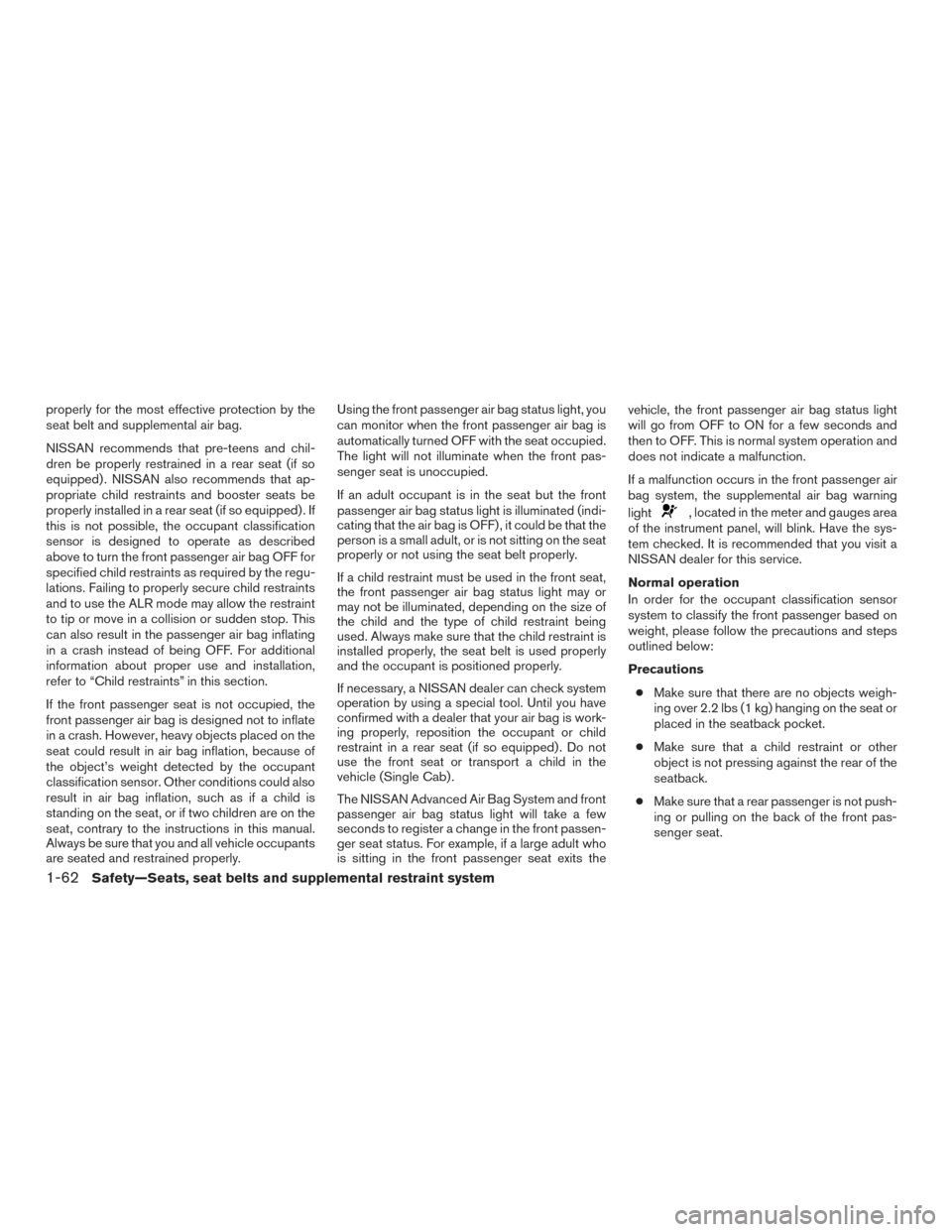
properly for the most effective protection by the
seat belt and supplemental air bag.
NISSAN recommends that pre-teens and chil-
dren be properly restrained in a rear seat (if so
equipped) . NISSAN also recommends that ap-
propriate child restraints and booster seats be
properly installed in a rear seat (if so equipped) . If
this is not possible, the occupant classification
sensor is designed to operate as described
above to turn the front passenger air bag OFF for
specified child restraints as required by the regu-
lations. Failing to properly secure child restraints
and to use the ALR mode may allow the restraint
to tip or move in a collision or sudden stop. This
can also result in the passenger air bag inflating
in a crash instead of being OFF. For additional
information about proper use and installation,
refer to “Child restraints” in this section.
If the front passenger seat is not occupied, the
front passenger air bag is designed not to inflate
in a crash. However, heavy objects placed on the
seat could result in air bag inflation, because of
the object’s weight detected by the occupant
classification sensor. Other conditions could also
result in air bag inflation, such as if a child is
standing on the seat, or if two children are on the
seat, contrary to the instructions in this manual.
Always be sure that you and all vehicle occupants
are seated and restrained properly.Using the front passenger air bag status light, you
can monitor when the front passenger air bag is
automatically turned OFF with the seat occupied.
The light will not illuminate when the front pas-
senger seat is unoccupied.
If an adult occupant is in the seat but the front
passenger air bag status light is illuminated (indi-
cating that the air bag is OFF) , it could be that the
person is a small adult, or is not sitting on the seat
properly or not using the seat belt properly.
If a child restraint must be used in the front seat,
the front passenger air bag status light may or
may not be illuminated, depending on the size of
the child and the type of child restraint being
used. Always make sure that the child restraint is
installed properly, the seat belt is used properly
and the occupant is positioned properly.
If necessary, a NISSAN dealer can check system
operation by using a special tool. Until you have
confirmed with a dealer that your air bag is work-
ing properly, reposition the occupant or child
restraint in a rear seat (if so equipped) . Do not
use the front seat or transport a child in the
vehicle (Single Cab) .
The NISSAN Advanced Air Bag System and front
passenger air bag status light will take a few
seconds to register a change in the front passen-
ger seat status. For example, if a large adult who
is sitting in the front passenger seat exits thevehicle, the front passenger air bag status light
will go from OFF to ON for a few seconds and
then to OFF. This is normal system operation and
does not indicate a malfunction.
If a malfunction occurs in the front passenger air
bag system, the supplemental air bag warning
light
, located in the meter and gauges area
of the instrument panel, will blink. Have the sys-
tem checked. It is recommended that you visit a
NISSAN dealer for this service.
Normal operation
In order for the occupant classification sensor
system to classify the front passenger based on
weight, please follow the precautions and steps
outlined below:
Precautions
● Make sure that there are no objects weigh-
ing over 2.2 lbs (1 kg) hanging on the seat or
placed in the seatback pocket.
● Make sure that a child restraint or other
object is not pressing against the rear of the
seatback.
● Make sure that a rear passenger is not push-
ing or pulling on the back of the front pas-
senger seat.
1-62Safety—Seats, seat belts and supplemental restraint system
Page 86 of 671
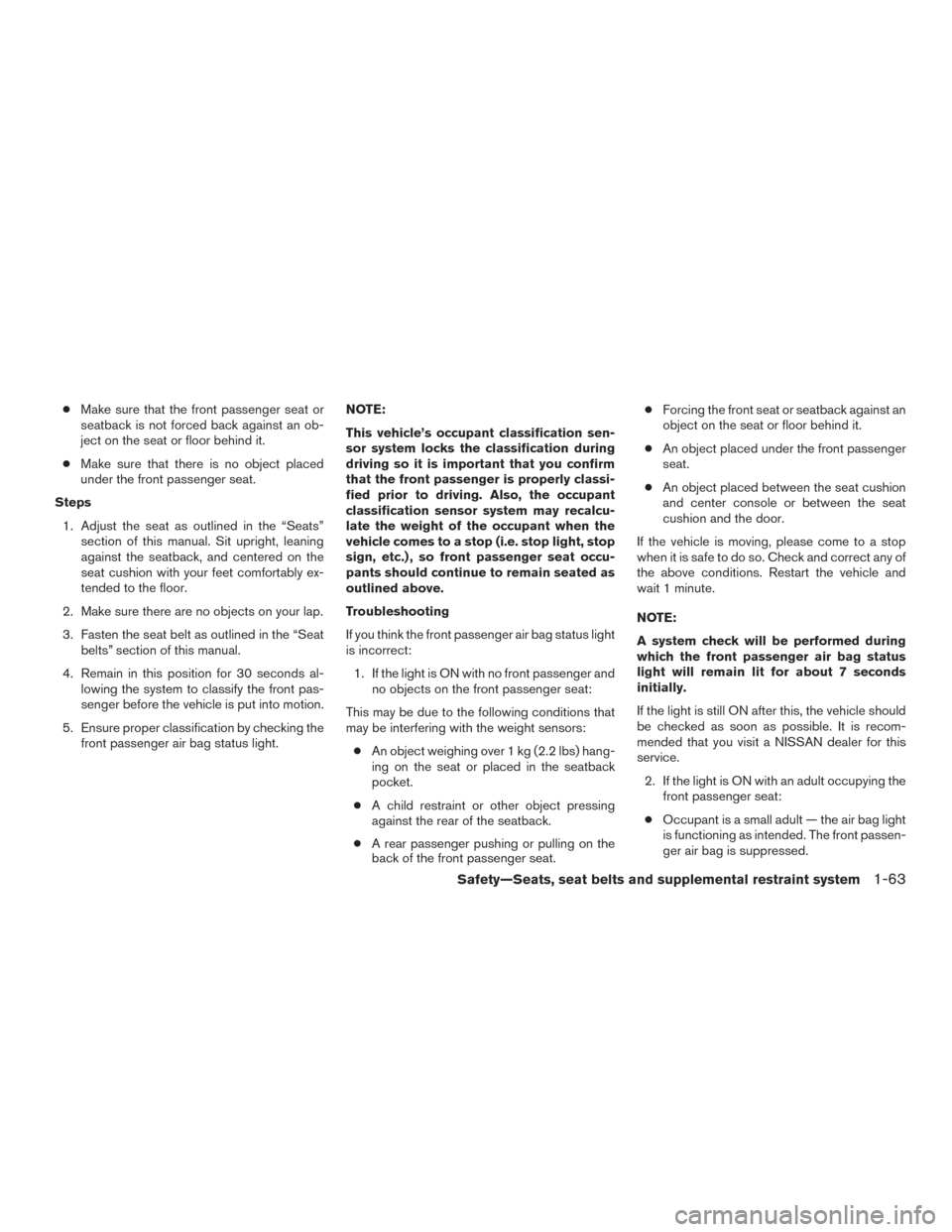
●Make sure that the front passenger seat or
seatback is not forced back against an ob-
ject on the seat or floor behind it.
● Make sure that there is no object placed
under the front passenger seat.
Steps 1. Adjust the seat as outlined in the “Seats” section of this manual. Sit upright, leaning
against the seatback, and centered on the
seat cushion with your feet comfortably ex-
tended to the floor.
2. Make sure there are no objects on your lap.
3. Fasten the seat belt as outlined in the “Seat belts” section of this manual.
4. Remain in this position for 30 seconds al- lowing the system to classify the front pas-
senger before the vehicle is put into motion.
5. Ensure proper classification by checking the front passenger air bag status light. NOTE:
This vehicle’s occupant classification sen-
sor system locks the classification during
driving so it is important that you confirm
that the front passenger is properly classi-
fied prior to driving. Also, the occupant
classification sensor system may recalcu-
late the weight of the occupant when the
vehicle comes to a stop (i.e. stop light, stop
sign, etc.) , so front passenger seat occu-
pants should continue to remain seated as
outlined above.
Troubleshooting
If you think the front passenger air bag status light
is incorrect:
1. If the light is ON with no front passenger and no objects on the front passenger seat:
This may be due to the following conditions that
may be interfering with the weight sensors: ● An object weighing over 1 kg (2.2 lbs) hang-
ing on the seat or placed in the seatback
pocket.
● A child restraint or other object pressing
against the rear of the seatback.
● A rear passenger pushing or pulling on the
back of the front passenger seat. ●
Forcing the front seat or seatback against an
object on the seat or floor behind it.
● An object placed under the front passenger
seat.
● An object placed between the seat cushion
and center console or between the seat
cushion and the door.
If the vehicle is moving, please come to a stop
when it is safe to do so. Check and correct any of
the above conditions. Restart the vehicle and
wait 1 minute.
NOTE:
A system check will be performed during
which the front passenger air bag status
light will remain lit for about 7 seconds
initially.
If the light is still ON after this, the vehicle should
be checked as soon as possible. It is recom-
mended that you visit a NISSAN dealer for this
service. 2. If the light is ON with an adult occupying the front passenger seat:
● Occupant is a small adult — the air bag light
is functioning as intended. The front passen-
ger air bag is suppressed.
Safety—Seats, seat belts and supplemental restraint system1-63
Page 87 of 671
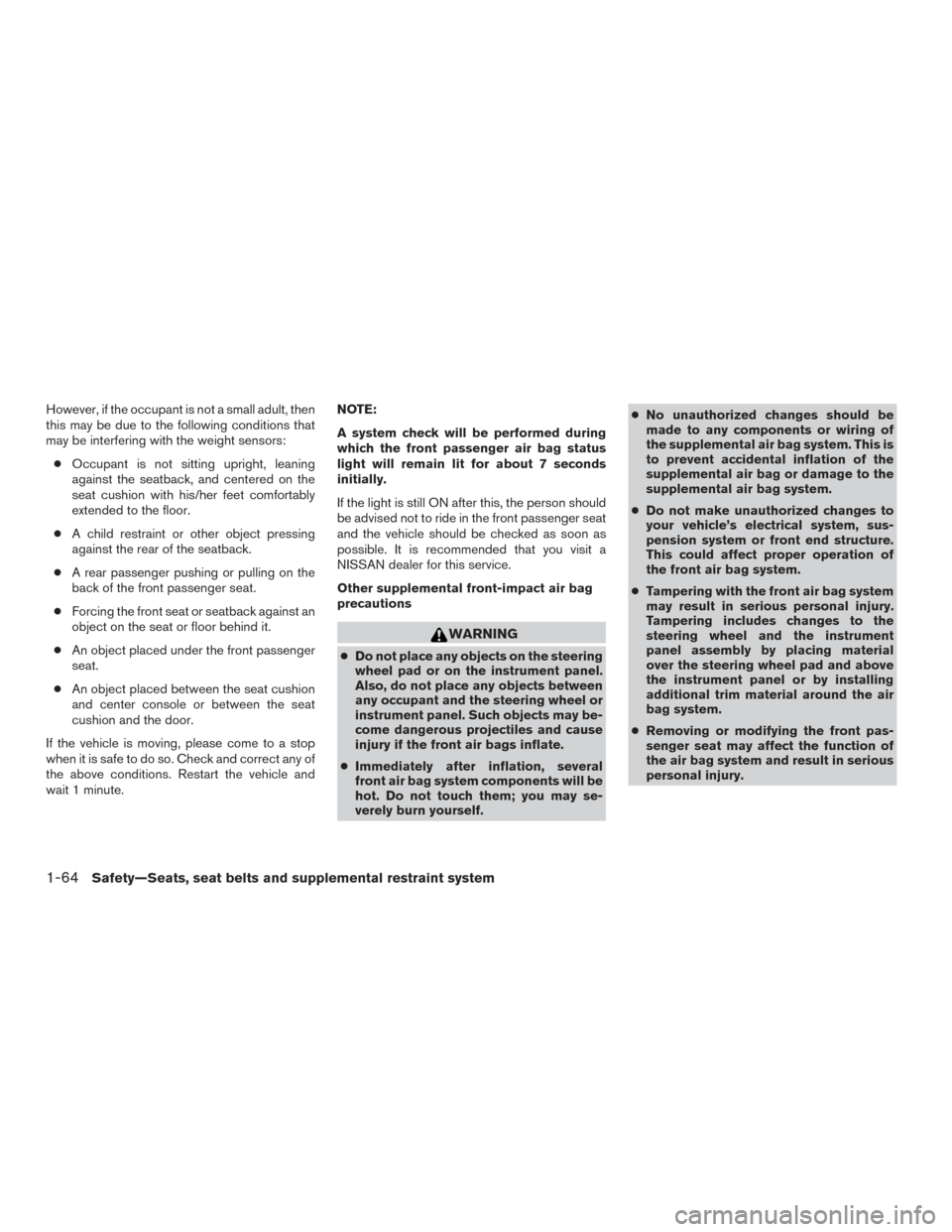
However, if the occupant is not a small adult, then
this may be due to the following conditions that
may be interfering with the weight sensors:● Occupant is not sitting upright, leaning
against the seatback, and centered on the
seat cushion with his/her feet comfortably
extended to the floor.
● A child restraint or other object pressing
against the rear of the seatback.
● A rear passenger pushing or pulling on the
back of the front passenger seat.
● Forcing the front seat or seatback against an
object on the seat or floor behind it.
● An object placed under the front passenger
seat.
● An object placed between the seat cushion
and center console or between the seat
cushion and the door.
If the vehicle is moving, please come to a stop
when it is safe to do so. Check and correct any of
the above conditions. Restart the vehicle and
wait 1 minute. NOTE:
A system check will be performed during
which the front passenger air bag status
light will remain lit for about 7 seconds
initially.
If the light is still ON after this, the person should
be advised not to ride in the front passenger seat
and the vehicle should be checked as soon as
possible. It is recommended that you visit a
NISSAN dealer for this service.
Other supplemental front-impact air bag
precautions
WARNING
●
Do not place any objects on the steering
wheel pad or on the instrument panel.
Also, do not place any objects between
any occupant and the steering wheel or
instrument panel. Such objects may be-
come dangerous projectiles and cause
injury if the front air bags inflate.
● Immediately after inflation, several
front air bag system components will be
hot. Do not touch them; you may se-
verely burn yourself. ●
No unauthorized changes should be
made to any components or wiring of
the supplemental air bag system. This is
to prevent accidental inflation of the
supplemental air bag or damage to the
supplemental air bag system.
● Do not make unauthorized changes to
your vehicle’s electrical system, sus-
pension system or front end structure.
This could affect proper operation of
the front air bag system.
● Tampering with the front air bag system
may result in serious personal injury.
Tampering includes changes to the
steering wheel and the instrument
panel assembly by placing material
over the steering wheel pad and above
the instrument panel or by installing
additional trim material around the air
bag system.
● Removing or modifying the front pas-
senger seat may affect the function of
the air bag system and result in serious
personal injury.
1-64Safety—Seats, seat belts and supplemental restraint system
Page 88 of 671

●Modifying or tampering with the front
passenger seat may result in serious
personal injury. For example, do not
change the front seats by placing mate-
rial on the seat cushion or by installing
additional trim material, such as seat
covers, on the seat that are not specifi-
cally designed to assure proper air bag
operation. Additionally, do not stow any
objects under the front passenger seat
or the seat cushion and seatback. Such
objects may interfere with the proper
operation of the occupant classification
sensor (weight sensor) .
● No unauthorized changes should be
made to any components or wiring of
the seat belt system. This may affect the
front air bag system. Tampering with
the seat belt system may result in seri-
ous personal injury. ●
It is recommended that you visit a
NISSAN dealer for work on and around
the front air bag. It is also recom-
mended that you visit a NISSAN dealer
for installation of electrical equipment.
The Supplemental Restraint System
(SRS) wiring harnesses* should not be
modified or disconnected. Unauthor-
ized electrical test equipment and prob-
ing devices should not be used on the
air bag system.
● A cracked windshield should be re-
placed immediately by a qualified repair
facility. A cracked windshield could af-
fect the function of the supplemental air
bag system.
*The SRS wiring harness connectors are
yellow and orange for easy identification.
When selling your vehicle, we request that you
inform the buyer about the front air bag system
and guide the buyer to the appropriate sections
in this Owner’s Manual.PRECAUTIONS ON SRS (without
NISSAN Advanced Air Bag System) (if
so equipped)
This SRS section contains important information
concerning the following systems: ● Driver and front passenger supplemental
front-impact air bag
● Front seat-mounted side-impact supple-
mental air bag
● Roof-mounted curtain side-impact and roll-
over supplemental air bag
● Seat belt with pretensioner(s) (front seats)
Supplemental front-impact air bag system
This system can help cushion the impact force to
the head and chest of the driver and right front
passenger in certain frontal collisions.
Front seat-mounted side-impact supple-
mental air bag system
This system can help cushion the impact force to
the chest area of the driver and right front pas-
senger in certain side impact collisions. The side
air bag is designed to inflate on the side where
the vehicle is impacted.
Safety—Seats, seat belts and supplemental restraint system1-65
Page 89 of 671
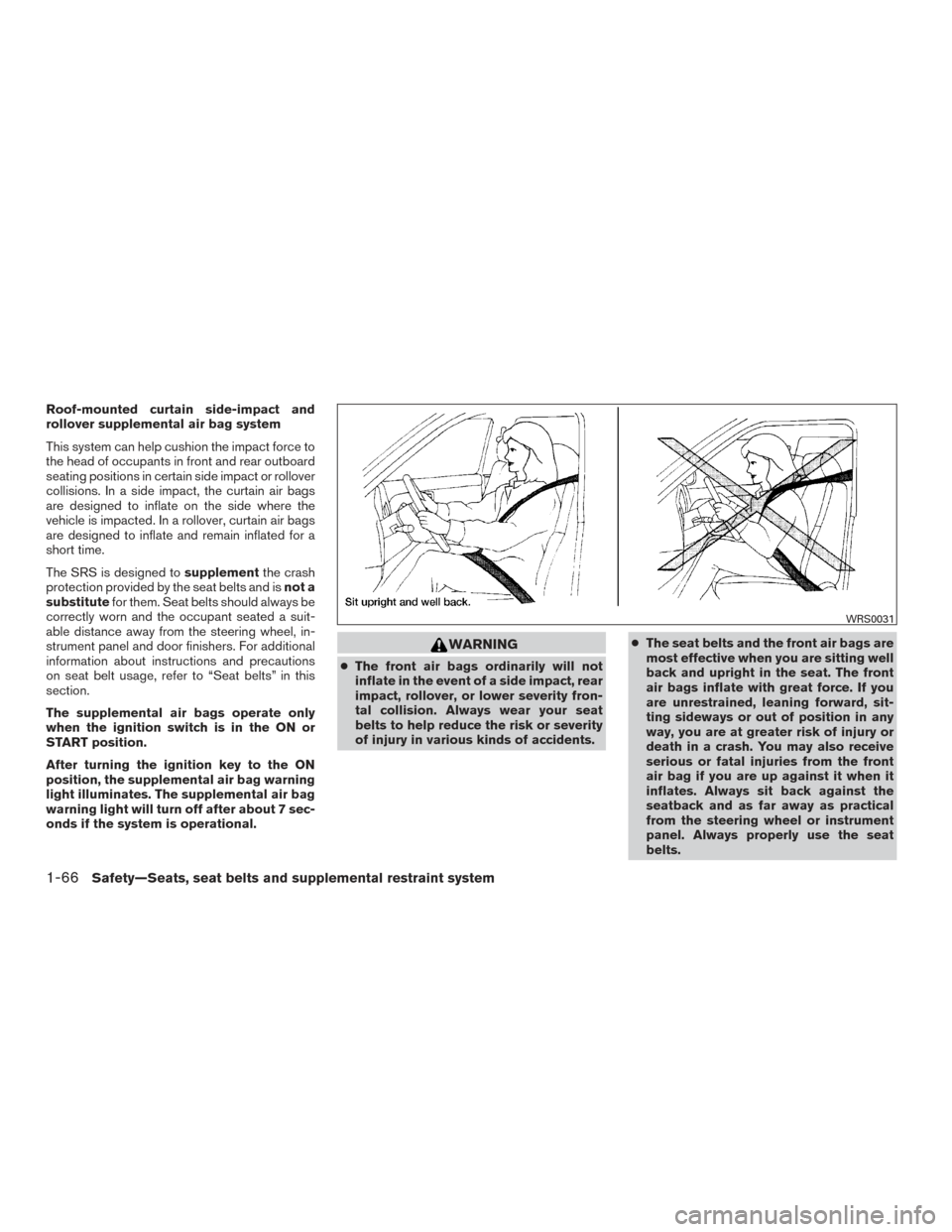
Roof-mounted curtain side-impact and
rollover supplemental air bag system
This system can help cushion the impact force to
the head of occupants in front and rear outboard
seating positions in certain side impact or rollover
collisions. In a side impact, the curtain air bags
are designed to inflate on the side where the
vehicle is impacted. In a rollover, curtain air bags
are designed to inflate and remain inflated for a
short time.
The SRS is designed tosupplementthe crash
protection provided by the seat belts and is not a
substitute for them. Seat belts should always be
correctly worn and the occupant seated a suit-
able distance away from the steering wheel, in-
strument panel and door finishers. For additional
information about instructions and precautions
on seat belt usage, refer to “Seat belts” in this
section.
The supplemental air bags operate only
when the ignition switch is in the ON or
START position.
After turning the ignition key to the ON
position, the supplemental air bag warning
light illuminates. The supplemental air bag
warning light will turn off after about 7 sec-
onds if the system is operational.
WARNING
● The front air bags ordinarily will not
inflate in the event of a side impact, rear
impact, rollover, or lower severity fron-
tal collision. Always wear your seat
belts to help reduce the risk or severity
of injury in various kinds of accidents. ●
The seat belts and the front air bags are
most effective when you are sitting well
back and upright in the seat. The front
air bags inflate with great force. If you
are unrestrained, leaning forward, sit-
ting sideways or out of position in any
way, you are at greater risk of injury or
death in a crash. You may also receive
serious or fatal injuries from the front
air bag if you are up against it when it
inflates. Always sit back against the
seatback and as far away as practical
from the steering wheel or instrument
panel. Always properly use the seat
belts.
WRS0031
1-66Safety—Seats, seat belts and supplemental restraint system
Page 90 of 671

●The driver and front passenger seat belt
buckles are equipped with sensors that
detect if the seat belts are fastened. The
air bag system monitors the severity of
a collision and inflates the air bags as
needed. Failure to properly wear seat
belts can increase the risk or severity of
injury in an accident.
● Keep hands on the outside of the steer-
ing wheel. Placing them inside the
steering wheel rim could increase the
risk that they are injured when the front
air bag inflates.
● The air bag system monitors the sever-
ity of a collision and then inflates the air
bags as needed. Failure to properly
wear seat belts can increase the risk or
severity of injury in an accident.
ARS1133
Safety—Seats, seat belts and supplemental restraint system1-67
Page 91 of 671
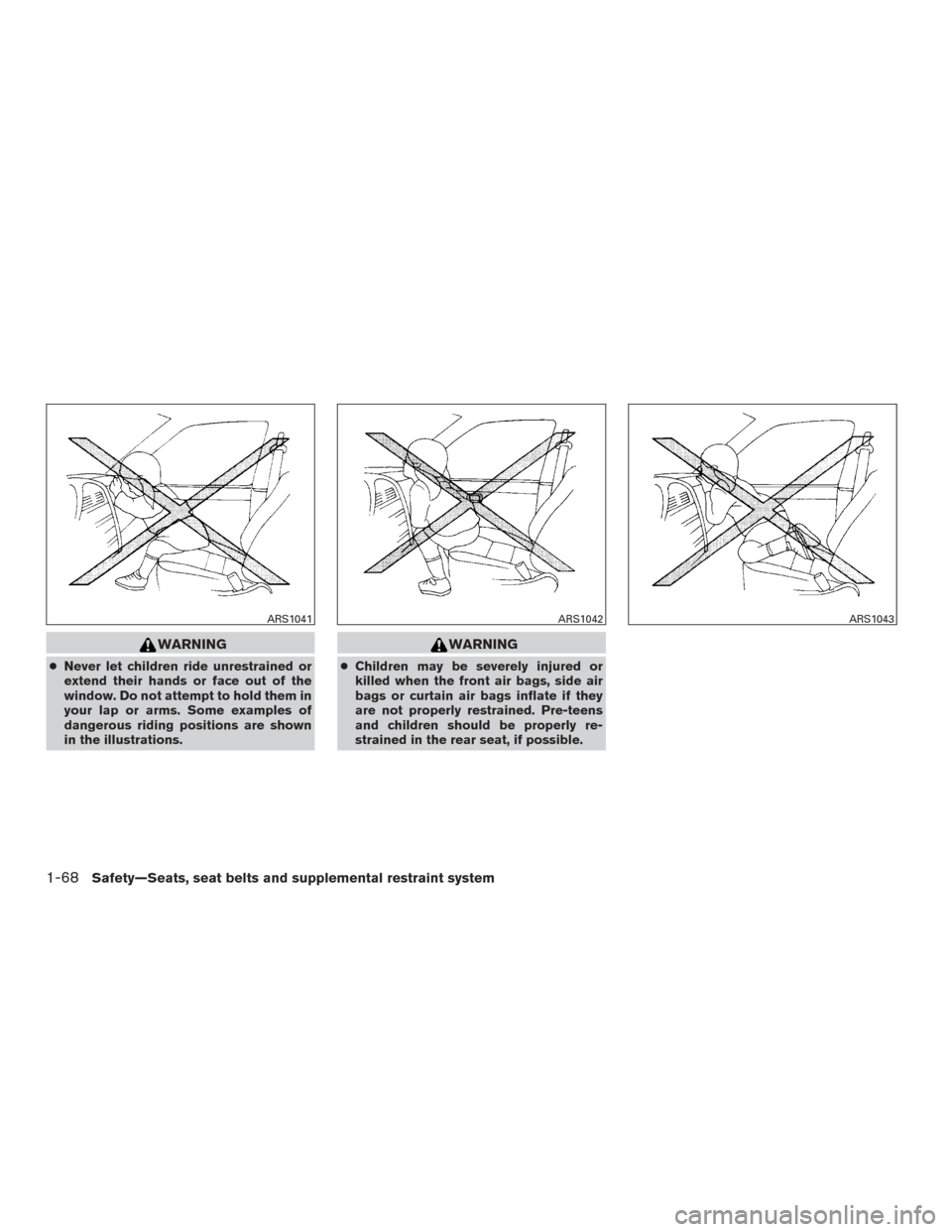
WARNING
●Never let children ride unrestrained or
extend their hands or face out of the
window. Do not attempt to hold them in
your lap or arms. Some examples of
dangerous riding positions are shown
in the illustrations.
WARNING
● Children may be severely injured or
killed when the front air bags, side air
bags or curtain air bags inflate if they
are not properly restrained. Pre-teens
and children should be properly re-
strained in the rear seat, if possible.
ARS1041ARS1042ARS1043
1-68Safety—Seats, seat belts and supplemental restraint system
Page 92 of 671
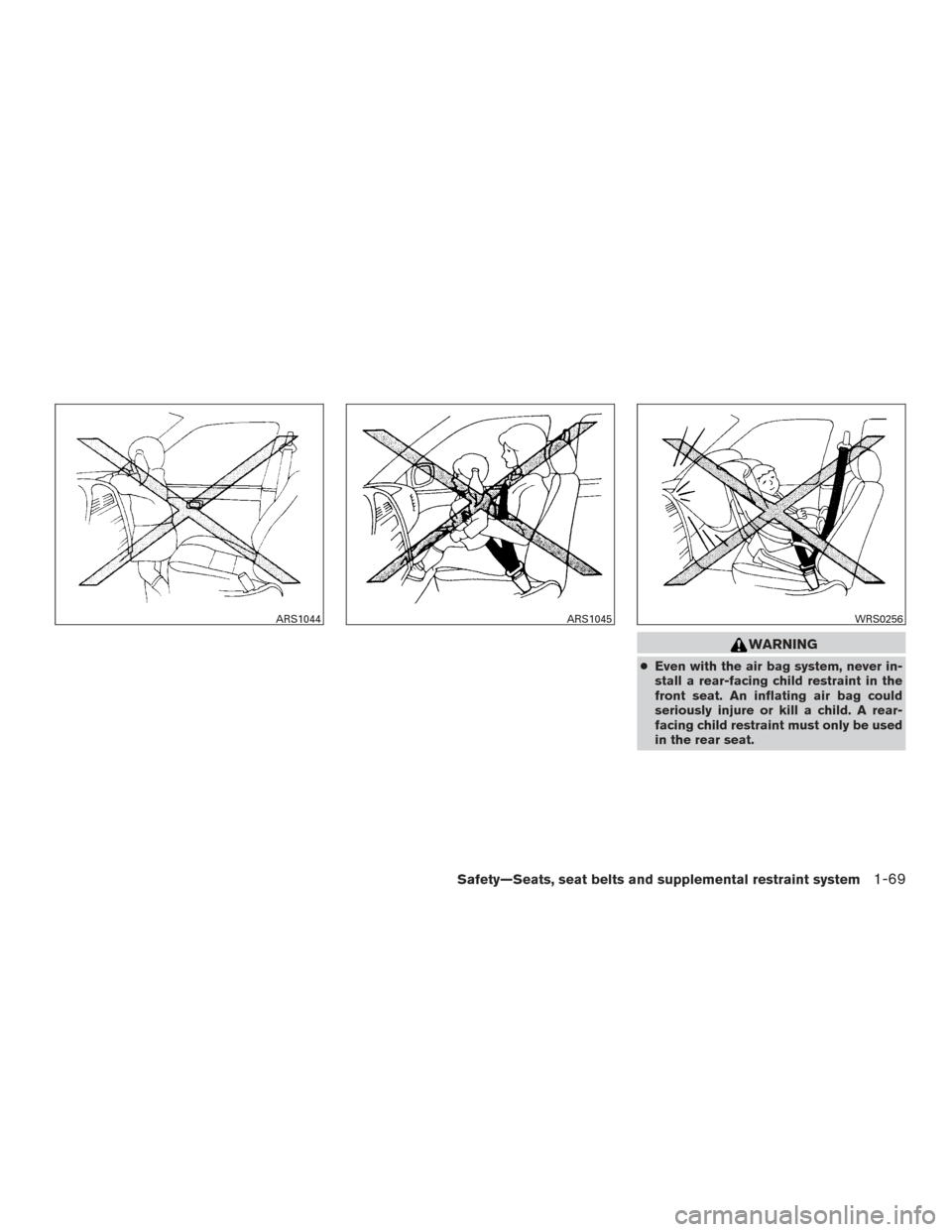
WARNING
●Even with the air bag system, never in-
stall a rear-facing child restraint in the
front seat. An inflating air bag could
seriously injure or kill a child. A rear-
facing child restraint must only be used
in the rear seat.
ARS1044ARS1045WRS0256
Safety—Seats, seat belts and supplemental restraint system1-69